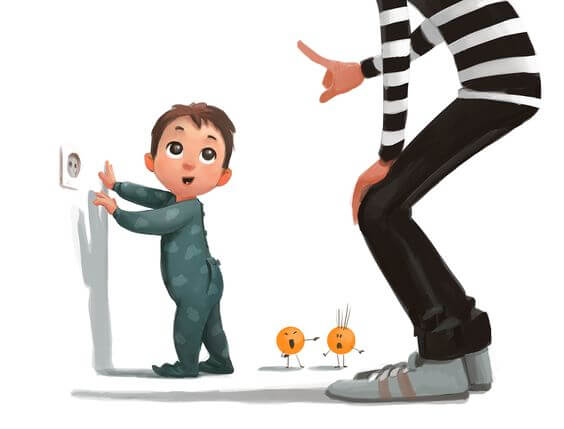Using Positive Discipline in Parenting and Education


Written and verified by the psychologist Valeria Sabater
In today’s article we’ll talk about an approach to education and parenting called positive discipline.
A healthy emotional education should include more phrases like: “I love you”, “I understand you”, and “I’m here for you”, and less “don’t do this” or “don’t do that.”
At the same time, we all know that in our children’s day-to-day life, limits are not just a recommendation, they are a necessity.
However, we shouldn’t allow warnings and prohibitions to be our child’s constant and perpetual background noise.
We must not create an environment where our child gets used to only negatives and brick walls, when all he desires is to see possibilities and open spaces.
As parents, we must believe in the natural potential of our children
-Alfred Adler-
We know it isn’t easy to find that balance. The truth is, educating our children is a daily act that comes with constant challenges.
We are required to apply a series of strategies based on our own values, and above all, on the needs that our children present.
Each one of our children will demand different types of guidance, effort and strategies based on their unique character and behavior.
That being said, despite whatever strategies we use with our children to solve their tantrums, fears, needs, etc., there is one aspect that we can never leave out of the picture.
In fact, there is something we should never underestimate: the intrinsic value of the word “NO.” Why?
Are you prepared to reflect on the impact that the word “NO” in a sentence has on our brain when we hear it throughout the day?
We want to talk about that today on You Are Mom.
Our brain doesn’t understand the word “no”

This is an interesting detail to reflect on. Our brains think in images. When we hear the word “no” or “not” or “don’t,” this immediately causes us to feel a predominantly negative emotion.
The same is true for children. It’s difficult for our brains to process the concept of negation, and even more so if we take into account that the mind is very stubborn, rebellious and incisive.
Sometimes all someone has to do is say “don’t think about red apples,” and suddenly, we can’t think about anything else.
So, when we talk in educational terms, we need to avoid using the words “no”, “not” and “don’t” lightly.
We should especially stay away from saying these phrases repeatedly: “Don’t touch that, don’t do that, don’t open that, don’t eat that, don’t go in there…”
Because if we don’t, the only results we will achieve are the following:
- Increasing our child’s sense of frustration and negativity.
- Over time, if we overuse these words, they will eventually lose their value.
Explain the reason behind your “no”
It’s as simple as that. Rather than just leaving things at “don’t touch” or “don’t go there,” the best thing to do is provide an explanation that reduces the negative feelings and sense of confrontation.
If you touch that, you could get hurt because it’s sharp… because it’s hot… because it’s dangerous.
Or: “Mom doesn’t want you to go out on the balcony because you could fall. Stay here with me so we can be together.”
- As you can see, by offering our children a simple and affectionate explanation, we can often avoid the “no” which in and of itself produces multiple negative emotions in our brains, no matter what our age.
So, when the time comes to set limits, warnings, and those always necessary prohibitions, we must also give a reason. This will take time, patience, and a large dose of affection.
But the results will be worth it.

Positive discipline: Educating through affection and saying “I love you”
Positive discipline is nothing new. It was psychiatrist Alfred Adler (Vienna 1870-1937) who came up with the theory of social development, in which he explained children’s need to always experience the connection to their immediate surrounding and to their society in a close and positive way.
This is our mission with children: to cast a ray of light and move on
-María Montessori-
One way to achieve this union, this connection, is through education – an education that is always respectful and intuitive, always egalitarian and democratic.
We should never allow ourselves to fall into a power struggle where punishment, imposition and shouting create a sense of constant fear of the power figure. These factors create a serious impact on a child’s brain.
Below, we will explain the key principles of positive discipline, where saying phrases like “I love you”, “I understand you” and “I support you” abound; and phrases like “don’t do that”, “don’t say that”, “don’t touch” and “don’t move” are all scarce.

How to apply positive discipline
We should put into practice a motivational education, in which we establish firm but encouraging guidelines.
We must set limits that should be respected at all times, and we must explain these limits in a way that is understandable to our children so that they can identify them and obey them naturally without acting against out them.
- We should work to always make our children feel valued, understood and loved.
- Mistakes should not be punished with shouting or criticism, but rather we should explain to our children how to resolve, improve and overcome their mistakes successfully because “we trust them.”
- At the same time, we will be teaching them life skills: Respect, problem-solving skills, responsibility, autonomy, and collaboration…
- We should also aim to help our children be aware of their abilities in order to use them to their full potential and to feel useful, courageous and capable of reaching their own goals.
In conclusion, educating through saying “I love you” doesn’t mean taking the easy way out or being permissive. It means knowing how to develop abilities, coping skills, positive emotions and the courage to connect positively to everything around them.
In today’s article we’ll talk about an approach to education and parenting called positive discipline.
A healthy emotional education should include more phrases like: “I love you”, “I understand you”, and “I’m here for you”, and less “don’t do this” or “don’t do that.”
At the same time, we all know that in our children’s day-to-day life, limits are not just a recommendation, they are a necessity.
However, we shouldn’t allow warnings and prohibitions to be our child’s constant and perpetual background noise.
We must not create an environment where our child gets used to only negatives and brick walls, when all he desires is to see possibilities and open spaces.
As parents, we must believe in the natural potential of our children
-Alfred Adler-
We know it isn’t easy to find that balance. The truth is, educating our children is a daily act that comes with constant challenges.
We are required to apply a series of strategies based on our own values, and above all, on the needs that our children present.
Each one of our children will demand different types of guidance, effort and strategies based on their unique character and behavior.
That being said, despite whatever strategies we use with our children to solve their tantrums, fears, needs, etc., there is one aspect that we can never leave out of the picture.
In fact, there is something we should never underestimate: the intrinsic value of the word “NO.” Why?
Are you prepared to reflect on the impact that the word “NO” in a sentence has on our brain when we hear it throughout the day?
We want to talk about that today on You Are Mom.
Our brain doesn’t understand the word “no”

This is an interesting detail to reflect on. Our brains think in images. When we hear the word “no” or “not” or “don’t,” this immediately causes us to feel a predominantly negative emotion.
The same is true for children. It’s difficult for our brains to process the concept of negation, and even more so if we take into account that the mind is very stubborn, rebellious and incisive.
Sometimes all someone has to do is say “don’t think about red apples,” and suddenly, we can’t think about anything else.
So, when we talk in educational terms, we need to avoid using the words “no”, “not” and “don’t” lightly.
We should especially stay away from saying these phrases repeatedly: “Don’t touch that, don’t do that, don’t open that, don’t eat that, don’t go in there…”
Because if we don’t, the only results we will achieve are the following:
- Increasing our child’s sense of frustration and negativity.
- Over time, if we overuse these words, they will eventually lose their value.
Explain the reason behind your “no”
It’s as simple as that. Rather than just leaving things at “don’t touch” or “don’t go there,” the best thing to do is provide an explanation that reduces the negative feelings and sense of confrontation.
If you touch that, you could get hurt because it’s sharp… because it’s hot… because it’s dangerous.
Or: “Mom doesn’t want you to go out on the balcony because you could fall. Stay here with me so we can be together.”
- As you can see, by offering our children a simple and affectionate explanation, we can often avoid the “no” which in and of itself produces multiple negative emotions in our brains, no matter what our age.
So, when the time comes to set limits, warnings, and those always necessary prohibitions, we must also give a reason. This will take time, patience, and a large dose of affection.
But the results will be worth it.

Positive discipline: Educating through affection and saying “I love you”
Positive discipline is nothing new. It was psychiatrist Alfred Adler (Vienna 1870-1937) who came up with the theory of social development, in which he explained children’s need to always experience the connection to their immediate surrounding and to their society in a close and positive way.
This is our mission with children: to cast a ray of light and move on
-María Montessori-
One way to achieve this union, this connection, is through education – an education that is always respectful and intuitive, always egalitarian and democratic.
We should never allow ourselves to fall into a power struggle where punishment, imposition and shouting create a sense of constant fear of the power figure. These factors create a serious impact on a child’s brain.
Below, we will explain the key principles of positive discipline, where saying phrases like “I love you”, “I understand you” and “I support you” abound; and phrases like “don’t do that”, “don’t say that”, “don’t touch” and “don’t move” are all scarce.

How to apply positive discipline
We should put into practice a motivational education, in which we establish firm but encouraging guidelines.
We must set limits that should be respected at all times, and we must explain these limits in a way that is understandable to our children so that they can identify them and obey them naturally without acting against out them.
- We should work to always make our children feel valued, understood and loved.
- Mistakes should not be punished with shouting or criticism, but rather we should explain to our children how to resolve, improve and overcome their mistakes successfully because “we trust them.”
- At the same time, we will be teaching them life skills: Respect, problem-solving skills, responsibility, autonomy, and collaboration…
- We should also aim to help our children be aware of their abilities in order to use them to their full potential and to feel useful, courageous and capable of reaching their own goals.
In conclusion, educating through saying “I love you” doesn’t mean taking the easy way out or being permissive. It means knowing how to develop abilities, coping skills, positive emotions and the courage to connect positively to everything around them.
All cited sources were thoroughly reviewed by our team to ensure their quality, reliability, currency, and validity. The bibliography of this article was considered reliable and of academic or scientific accuracy.
- Bowlby, J. (1986). Vínculos afectivos: formación, desarrollo y pérdida. Madrid: Morata.
- Bowlby, J. (1995). Teoría del apego. Lebovici, Weil-HalpernF.
- Garrido-Rojas, L. (2006). Apego, emoción y regulación emocional. Implicaciones para la salud. Revista latinoamericana de psicología, 38(3), 493-507. https://www.redalyc.org/pdf/805/80538304.pdf
- Marrone, M., Diamond, N., Juri, L., & Bleichmar, H. (2001). La teoría del apego: un enfoque actual. Madrid: Psimática.
- Moneta, M. (2003). El Apego. Aspectos clínicos y psicobiológicos de la díada madre-hijo. Santiago: Cuatro Vientos.
This text is provided for informational purposes only and does not replace consultation with a professional. If in doubt, consult your specialist.








